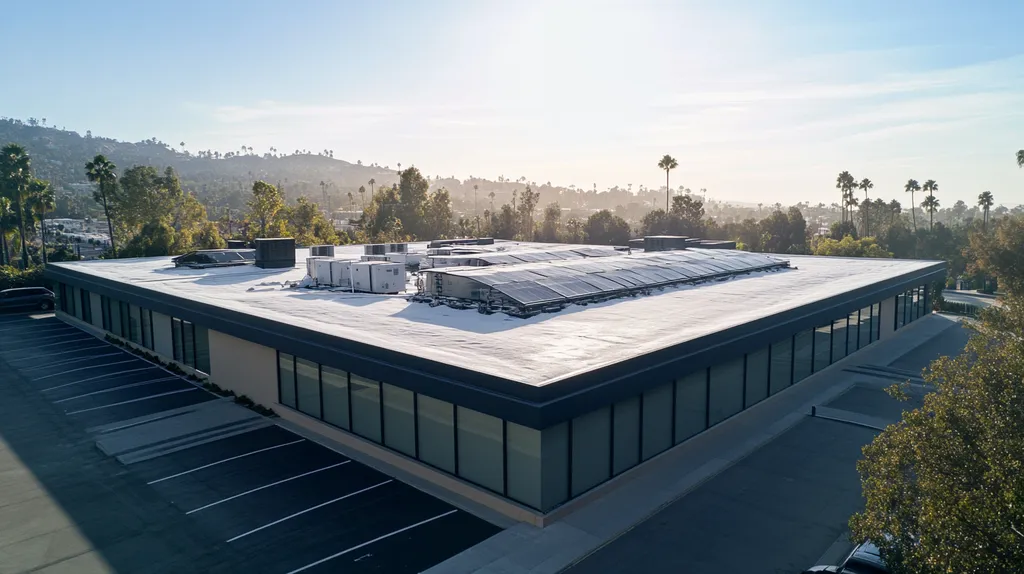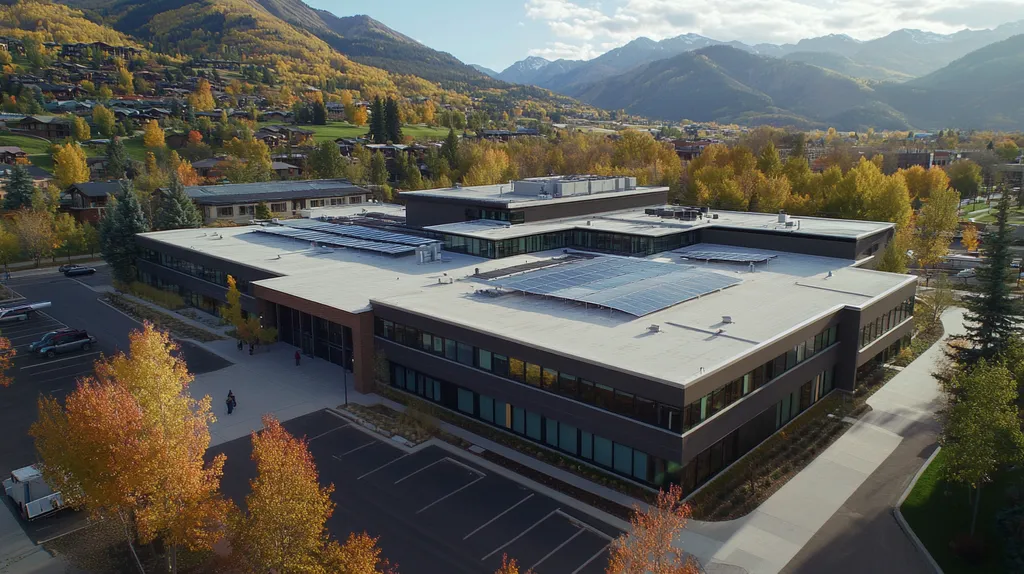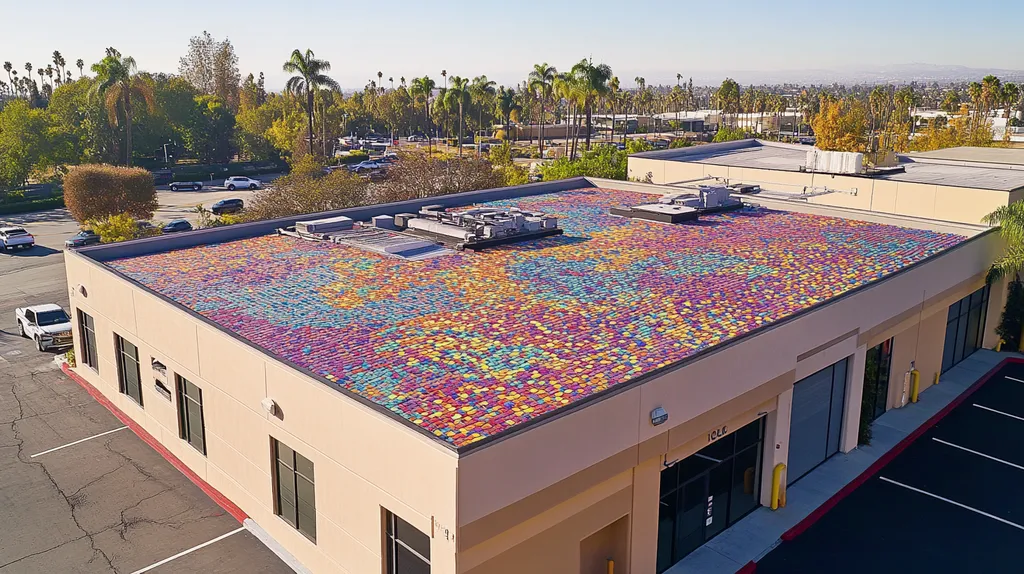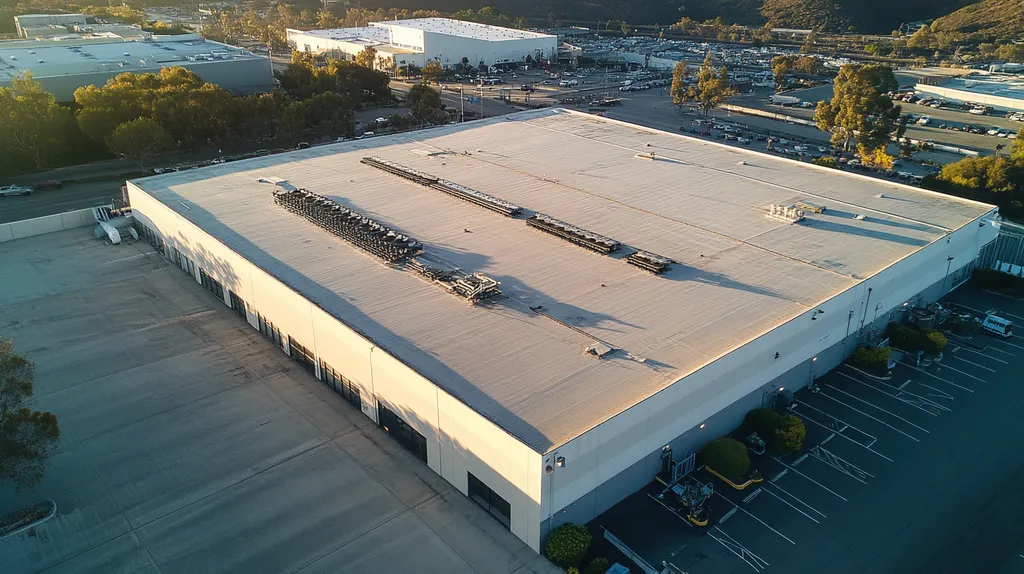In today’s economy, commercial roofing decisions can make or break a building’s profitability. Studies show that inefficient roofing systems waste up to 40% of heating and cooling energy while requiring replacement twice as often as optimized solutions.
From material selection to maintenance protocols, every roofing choice impacts decades of operational costs. Modern commercial roofs must integrate advanced materials, smart monitoring systems, and strategic maintenance plans to maximize long-term savings.
This comprehensive guide examines the critical components, implementation methods, and optimization strategies that deliver measurable returns through reduced energy consumption, extended service life, and minimized maintenance costs.
SECTION 1: FUNDAMENTAL CONCEPTS
In today’s commercial real estate landscape, roofing decisions have never carried more financial weight. With energy costs surging 15-25% annually in many regions, the right roofing system can mean the difference between profit and loss. Modern commercial roofs must do more than simply protect buildings – they’re now critical components of energy management strategies that directly impact operational costs.
Overview of Commercial Roofing Systems and Efficiency
Commercial roofing systems encompass a spectrum of solutions, from traditional built-up roofing (BUR) to advanced single-ply membranes and emerging green roof technologies. Each system presents distinct advantages in specific applications, with performance varying by climate zone and building use.
Modern membrane systems, particularly TPO and PVC, have revolutionized commercial roofing by combining durability with superior energy performance. These materials reflect up to 85% of solar radiation, dramatically reducing cooling loads.
Installation quality significantly influences system performance. Proper attachment methods, seam welding, and flashing details can extend a roof’s service life by 25-40% while maintaining peak efficiency.
The selection process must balance initial costs against long-term performance metrics. A premium system’s higher upfront investment often delivers superior returns through reduced maintenance and energy savings.
Core Principles of Energy-Efficient Roofing
Energy-efficient roofing systems operate on three fundamental principles: reflection, insulation, and ventilation. Reflective surfaces minimize heat absorption, while proper insulation prevents thermal transfer between the building’s interior and exterior.
Environmental sustainability in commercial roofing encompasses both energy efficiency and materials longevity, directly contributing to long-term economic benefits. (source: National Main Street Center)
Strategic placement of vapor barriers and thermal breaks prevents condensation buildup, which can degrade insulation performance and accelerate material deterioration. These details are particularly crucial in humid climates.
Proper ventilation design ensures continuous air movement through the roof assembly, preventing heat buildup in summer and moisture accumulation in winter. This balanced approach maximizes system efficiency year-round.
Benefits of High-Performance Commercial Roofs
High-performance roofing systems deliver measurable returns through multiple channels. Energy savings typically range from 20-40% compared to traditional systems, with peak reductions during extreme weather conditions.
These systems extend roof service life by 30-50% through superior weather resistance and reduced thermal stress. The resulting decrease in maintenance and replacement frequency generates substantial lifetime savings.
Enhanced durability translates to improved disaster resilience, potentially reducing insurance premiums and minimizing business interruption risks. This protection becomes increasingly valuable as extreme weather events become more frequent.
Modern high-performance roofs contribute to building certification programs like LEED, potentially increasing property values and attracting quality tenants who prioritize sustainable operations.
SECTION 2: SYSTEM COMPONENTS
Modern commercial roofing has evolved beyond simple weather protection into sophisticated systems that drive significant cost savings. Studies show buildings with optimized roofing components reduce cooling costs by up to 40% compared to traditional systems. Understanding and selecting the right combination of materials, coatings, and ventilation solutions is crucial for maximizing these savings while extending roof lifespan.
Types of Reflective and Insulating Materials
Reflective materials form the first defense against solar heat gain. Single-ply membranes like TPO and PVC achieve solar reflectance values above 0.85, meaning they reflect 85% of incoming solar radiation before it can heat the building.
Modern polyisocyanurate insulation boards deliver R-values of 5.6 to 6.0 per inch, making them 30% more efficient than traditional options. These materials maintain their thermal performance even after years of service, unlike older materials that degrade rapidly.
Strategic layering of these components multiplies their effectiveness. A properly designed system pairs high-reflectance membranes with multiple insulation layers, creating thermal breaks that dramatically reduce heat transfer.
Material selection must account for local climate conditions and building use patterns. Cold storage facilities benefit from thicker insulation layers, while buildings in hot climates prioritize maximum reflectance values.
Roof Coatings and Their Role in Heat Reduction
Advanced roof coatings serve as both protective and thermal management systems. Modern elastomeric coatings can lower roof surface temperatures by 50-60°F during peak summer conditions.
Different coating types offer specialized benefits. Silicone coatings excel in extreme weather resistance, while acrylic coatings provide superior UV protection at lower cost points. Polyurethane variants deliver exceptional durability for high-traffic areas.
Application timing and preparation significantly impact coating performance. Proper surface cleaning and primer application can increase coating adhesion by 40%, extending service life and maintaining reflective properties.
Regular recoating schedules preserve thermal performance. Most systems require renewal every 5-10 years, with timing dependent on environmental exposure and wear patterns.
Ventilation and Drainage Essentials for Commercial Roofs
Proper ventilation prevents heat buildup and moisture accumulation that can degrade roofing components. A well-designed system exchanges air 3-4 times per hour, maintaining optimal temperature and humidity levels.
Strategic drain placement ensures complete water removal within 24 hours of precipitation. Industry standards recommend one drain per 1,500 square feet of roof area, with additional capacity in valleys and low spots.
Modern drainage solutions incorporate emergency overflow systems and smart monitoring. These features prevent catastrophic failures during extreme weather events and alert maintenance teams to potential blockages.
Integrated ventilation and drainage systems work together to extend material lifespan. Proper air movement accelerates drying after rain events, while efficient drainage prevents standing water that can degrade membrane materials.
SECTION 3: IMPLEMENTATION METHODS
The implementation phase of commercial roofing represents a critical juncture where strategic decisions directly impact decades of performance and cost. Studies show that improper implementation can reduce a roof’s lifespan by 40% while increasing energy costs by up to 30%. Modern implementation methods must balance immediate budget constraints against long-term performance metrics, especially as energy costs continue to rise.
Selecting the Right Roofing System for Climate and Use
Climate considerations fundamentally shape roofing system selection. In areas with high UV exposure, reflective membranes can reduce surface temperatures by up to 50°F, while regions with frequent precipitation require enhanced drainage capacity and moisture barriers.
Building use patterns dictate specific performance requirements. Data centers need maximum thermal efficiency, while manufacturing facilities might prioritize chemical resistance. Distribution centers often require reinforced systems to support regular maintenance traffic.
High-grade materials optimized for local conditions consistently deliver superior long-term value through extended service life and reduced maintenance requirements. (source: Fargo Roofing)
System compatibility with existing structures must be verified through detailed structural analysis. This evaluation prevents costly modifications and ensures the selected system can achieve its full performance potential.
Best Practices for Installation of Insulation and Coatings
Proper installation begins with comprehensive surface preparation. Even minor contamination can reduce adhesion by 40%, leading to premature system failure and increased maintenance costs.
Insulation installation demands precise attention to thermal breaks and vapor barriers. Gaps as small as 1/4 inch can reduce overall system efficiency by 25%, while improper vapor barrier placement accelerates insulation degradation.
Coating application requires strict environmental control. Temperature, humidity, and dew point must fall within manufacturer specifications to achieve proper cure and maximum durability.
Quality control procedures should include infrared scanning to verify uniform installation and identify potential weak points before they develop into costly problems.
Integrating Green Roofs and Solar Panels
Green roof integration starts with enhanced structural support calculations. Most systems add 25-40 pounds per square foot when saturated, requiring careful load distribution planning.
Solar panel installation demands precise attachment methods that maintain roof integrity. Modern mounting systems eliminate 90% of roof penetrations while providing secure anchoring for arrays.
Drainage patterns must accommodate both systems’ unique requirements. Green roof components need consistent moisture levels, while solar installations require clear paths for rainwater flow.
Combined systems deliver maximum value through synergistic benefits. Solar panels operate more efficiently with green roof cooling effects, while vegetation thrives in the partial shade provided by panel arrays.
SECTION 4: MAINTENANCE REQUIREMENTS
Research shows that up to 80% of commercial roof failures stem from inadequate maintenance rather than material defects. Without proper care, even premium roofing systems deteriorate rapidly, leading to premature replacement costs that can exceed $250,000 for a typical commercial building. Understanding and implementing proper maintenance protocols represents the difference between a roof lasting 10 years versus its full 30-year potential.
Routine Inspection Schedules and Protocols
Every commercial roof requires bi-annual professional inspections, supplemented by quarterly visual assessments from facility staff. These regular evaluations help identify potential issues before they escalate into major repairs.
A comprehensive inspection protocol should examine membrane condition, seam integrity, flashings, drainage systems, and mechanical penetrations. Special attention must focus on high-stress areas like corners, transitions, and equipment mounting points.
Modern inspection techniques incorporate infrared moisture detection and drone photography to identify hidden issues. These technologies can spot water infiltration long before visible damage appears.
Documentation through detailed reports and photographs creates a vital maintenance history. This record helps track deterioration patterns and optimize repair timing.
Identifying and Repairing Common Roofing Issues
Regular maintenance keeps roofing costs manageable by preventing small issues from escalating into major problems. Common issues like punctures, loose seams, and clogged drains require immediate attention to prevent water damage. (source: Polo14 Commercial Roofing Tips)
Surface deterioration often starts with minor blistering or cracking that can quickly expand during extreme weather. Early detection and repair of these issues prevents moisture infiltration into underlying insulation layers.
Flashing failures around roof penetrations represent a leading cause of leaks. Regular inspection and maintenance of these critical junctions prevents water intrusion that can compromise structural integrity.
Standing water must be addressed within 48 hours to prevent membrane degradation. Proper drainage maintenance, including regular clearing of gutters and drains, prevents costly ponding damage.
Long-Term Upkeep for Maximizing Roof Lifespan
Strategic maintenance planning extends beyond reactive repairs to include preventive measures that maximize system longevity. This approach includes scheduled cleaning, coating renewal, and systematic component replacement.
Seasonal maintenance requirements vary significantly by climate zone. Northern facilities need special attention to ice dam prevention, while southern locations focus on UV protection and heat management.
Chemical exposure from HVAC systems and industrial processes accelerates material degradation. Regular surface cleaning and protective treatments preserve membrane performance in these harsh environments.
Quality control during maintenance work proves essential for long-term performance. Proper material selection and installation techniques during repairs prevent premature failure of patched areas.
SECTION 5: PERFORMANCE METRICS
Commercial roof performance metrics directly impact building operational costs and long-term investment returns. Studies show that inefficient roofing systems can increase energy expenses by up to 40% while reducing expected service life by half. Modern performance monitoring combines solar reflectance measurement, energy consumption tracking, and durability assessment to optimize roof system efficiency and maximize returns on roofing investments.
Measuring Solar Reflectance Index (SRI) and Thermal Emittance
Solar Reflectance Index (SRI) quantifies a roof’s ability to reject solar heat, with values ranging from 0 to 100. Higher SRI values indicate superior heat rejection, with premium cool roofs achieving scores above 85.
Thermal emittance measures how effectively surfaces release absorbed heat. Modern roofing membranes combine high SRI with emittance values above 0.85, dramatically reducing cooling loads.
Regular SRI testing reveals performance degradation before it impacts building efficiency. Most cool roofs lose 10-15% of their reflective capacity within three years without proper maintenance.
Advanced measurement tools like spectrophotometers enable precise tracking of these metrics, helping facility managers optimize cleaning and recoating schedules.
Tracking Energy Consumption and Cost Savings
Energy consumption tracking requires establishing clear baseline measurements before implementing roofing improvements. This data enables accurate calculation of system performance and return on investment.
Building automation systems can isolate roof-related energy impacts by monitoring temperature variations across different building zones. These insights help identify areas where roof performance affects HVAC efficiency.
Cost savings analysis must account for both direct energy reductions and indirect benefits like extended equipment life. Proper roof performance often reduces HVAC maintenance needs by 15-25%.
The National Main Street Center emphasizes that sustainable roofing design practices significantly reduce long-term operational costs through improved energy efficiency and extended system life. (source: National Main Street Center)
Evaluating Roof Durability and Warranty Standards
Durability metrics encompass physical strength, weather resistance, and chemical stability. Premium roofing systems maintain these properties for 20-30 years under normal conditions.
Warranty standards provide crucial benchmarks for expected performance. Top manufacturers now offer 30-year coverage that includes specific performance guarantees for reflectivity and thermal resistance.
Impact resistance testing determines a roof’s ability to withstand mechanical damage. Systems rated for severe hail exposure typically deliver superior long-term performance in all environments.
Laboratory aging tests predict long-term durability by simulating decades of weather exposure. These results help facility managers select systems optimized for local climate conditions.
SECTION 6: OPTIMIZATION STRATEGIES
Commercial roof optimization has become a critical financial imperative, with inefficient systems costing businesses up to 40% more in energy expenses annually. As building operating costs continue to surge, strategic upgrades and retrofits can unlock significant savings through improved thermal performance and extended service life. Modern optimization approaches combine proven retrofit techniques with emerging technologies to maximize both immediate and long-term returns on roofing investments.
Retrofitting Existing Roofs for Enhanced Energy Efficiency
Most commercial roofs operate well below their efficiency potential, with dated materials and deteriorating components driving excessive energy consumption. Strategic retrofits can restore and often exceed original performance levels without full replacement costs.
Cool roof conversions represent one of the most cost-effective retrofit options. Installing reflective coatings or membranes can reduce peak roof temperatures by up to 50°F while decreasing cooling costs by 7% to 15%. (source: Polo 14)
Targeted insulation upgrades in deficient areas can eliminate thermal bridges that waste heating and cooling energy. Modern spray foam applications allow precise filling of gaps while providing superior air sealing.
Edge sealing and flashing reinforcement prevent air infiltration that bypasses insulation. These targeted improvements often deliver payback periods under three years through reduced HVAC loads.
Leveraging Advanced Materials and Technologies
Smart membrane systems with integrated monitoring capabilities enable real-time performance tracking and predictive maintenance. These technologies can detect moisture intrusion and thermal inefficiencies before they cause significant damage.
Phase-change materials incorporated into roofing assemblies actively manage heat flow, reducing peak loads by up to 30%. This technology is particularly effective in climates with large daily temperature swings.
Self-healing membranes containing reactive polymers can automatically seal minor punctures and tears. This capability extends service life while maintaining optimal thermal performance.
Advanced coating systems provide multi-layer protection while maximizing solar reflectance. These coatings can be renewed periodically to maintain peak efficiency throughout the roof’s service life.
Periodic Upgrades and Continuous Improvement Approaches
Systematic upgrade planning allows strategic implementation of improvements as technologies advance and building needs evolve. This approach prevents costly emergency replacements while capturing new efficiency opportunities.
Performance monitoring systems track key metrics like heat flux and moisture levels, enabling data-driven decisions about upgrade timing and scope. Regular analysis helps identify the most cost-effective improvement opportunities.
Phased implementation strategies spread costs while prioritizing areas with the highest potential returns. This approach maintains cash flow while steadily improving overall system performance.
Integration with building automation systems optimizes the coordination between roofing performance and HVAC operation. This synergy maximizes energy savings while extending equipment service life.
The Bottom Line
With energy costs rising 15-25% annually, commercial roofing decisions now directly impact millions in operational expenses over a building’s lifetime.
Studies confirm that inefficient roofing systems waste up to 40% of heating and cooling energy while requiring replacement twice as often as optimized solutions.
Modern commercial roofs must integrate advanced materials, smart monitoring systems, and strategic maintenance protocols to maximize returns.
By implementing the strategies outlined in this guide, facility managers can reduce energy costs by 20-40%, extend roof lifespan by 30-50%, and dramatically decrease maintenance expenses.
The time for proactive roofing optimization is now – every day of delay means lost savings and increased operational costs.
FREQUENTLY ASKED QUESTIONS
Q. How can a commercial roof affect long-term savings?
A. A commercial roof significantly influences energy costs and maintenance expenses, impacting overall savings. Choosing energy-efficient materials and installation methods can lead to lower utility bills and extended roof lifespan, thus reducing replacement costs over time.
Q. What are the best materials for an industrial roof system?
A. The best materials for an industrial roof often include TPO and PVC due to their durability and reflective properties. These materials help reduce energy costs and improve longevity, ultimately contributing to long-term savings.
Q. What are the key components of an energy-efficient commercial roof?
A. Key components include reflective membranes, insulation layers, and effective ventilation systems. These elements work together to minimize heat absorption, ensuring the roof operates efficiently and lasts longer.
Q. Why is proper installation essential for commercial roofs?
A. Proper installation is crucial as it ensures system durability and energy efficiency. Poorly installed roofs can lead to premature failure, increased maintenance, and higher operational costs over time.
Q. What maintenance is needed for commercial roofs?
A. Regular inspections, cleaning, and timely repairs are essential to maintaining a commercial roof. This proactive approach helps prevent significant damage, thus extending the roof’s lifespan and ensuring cost-effectiveness.
Q. How can energy consumption be tracked for commercial roofing?
A. Energy consumption can be tracked using building automation systems that monitor temperature variations and isolate energy impacts attributable to the roof. This data helps optimize energy efficiency and operational savings.
Q. What is the importance of roof performance metrics?
A. Performance metrics are vital as they directly affect energy costs and roof lifespan. Monitoring these metrics helps facility managers make informed decisions that optimize commercial roof efficiency and return on investment.











